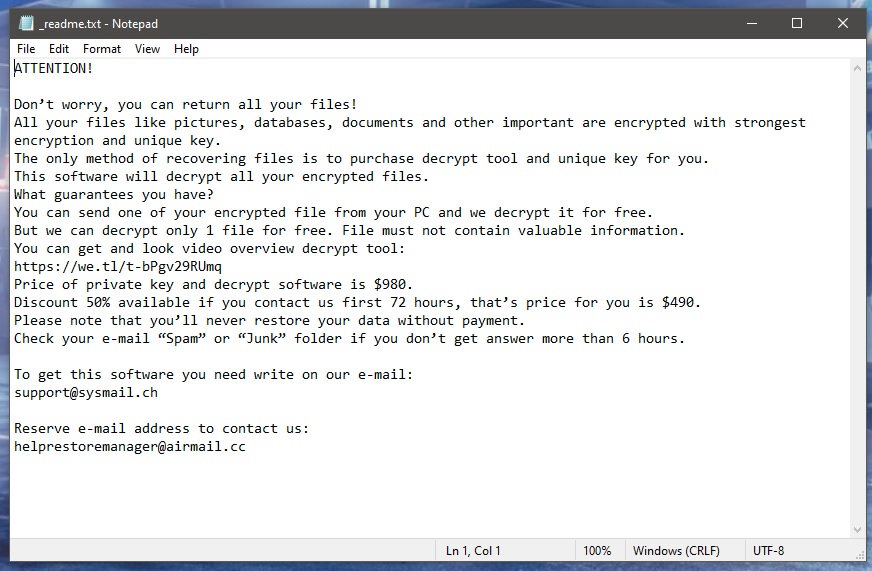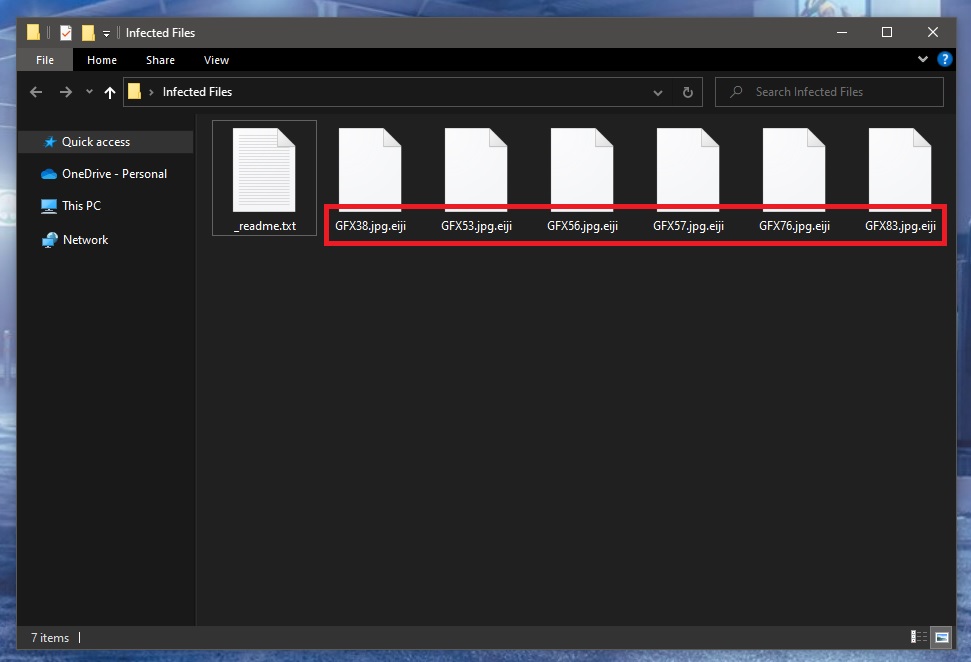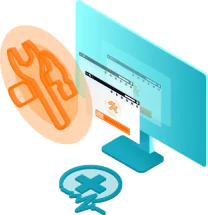Eiji
Eiji is a hazardous malware program that encrypts user data once it infects the targeted computer, thereby rendering the affected files inaccessible. The encryption Eiji places on the files keeps them locked up until a special key is used to decrypt the applied algorithm.

The main goal of the hackers behind these nefarious virus programs like Bbii, Bbzz is to get you to pay them a certain amount of money by sending it to their virtual wallets. In a pop-up message that the virus puts on your screen once it is finished with the encryption, the blackmailers tell you that you must send them money if you want to get your data back. Unless you complete their demands and follow all of their payment instructions, you will not receive the decryption key for your files.
Naturally, if you have been infected by this virus and some of your most important files have been locked, you’d likely feel frustrated and in your desperation to get your files back, you may opt for the payment alternative. You must, however, refrain from going for that option right away because there are several things that might go wrong with it. Firstly, if you receive a key from the hackers, that key might be corrupted, or it might not be the correct one (there is a unique key for each encryption instance, meaning that the key for another computer won’t work on your files). In such cases, you will probably not be given another key and your data will stay locked. The other potential problem that may occur is if the hackers simply refuse to send you anything for your money. In both of these cases, any money you send to the criminals will remain in their hands – you can expect no refunds from such people.
The Eiji virus
The Eiji virus is a malicious Ransomware virus for Windows computers that makes all user data on the infected machine unavailable. The Eiji virus uses encryption to seal the targeted data and even removing the virus itself won’t automatically restore access to the files.

However, it is still crucial that you make sure that the virus is removed. This will allow you to try some alternative recovery options and it will also prevent future encryption of any new files you may make in your computer. To remove Eiji from your system, follow the steps we have prepared for the readers of this article inside the guide down below.
The Eiji file extension
The Eiji file extension is a special filename suffix that replaces the original extensions of the files that are subjected to encryption. The Eiji file extension isn’t recognized by normal software because it doesn’t correspond to an existing file format.
Because of this, your programs won’t be able to open your files. The extension will remain on your files until the decryption key is applied. However, decryption using the matching decryption key might not be the only way to restore your data. After you complete the removal steps from below, head down to the second part of the guide, where you will find some alternative options that may help some of you get some of the encrypted data back.
SUMMARY:
| Name | Eiji |
| Type | Ransomware |
| Danger Level | High (Ransomware is by far the worst threat you can encounter) |
| Data Recovery Tool | Not Available |
| Detection Tool | Some threats reinstall themselves if you don't delete their core files. We recommend downloading SpyHunter to remove harmful programs for you. This may save you hours and ensure you don't harm your system by deleting the wrong files. |
Remove Eiji Ransomware

Some of the steps will likely require you to exit the page. Bookmark it for later reference.
Reboot in Safe Mode (use this guide if you don’t know how to do it).

WARNING! READ CAREFULLY BEFORE PROCEEDING!
*Read more details in the first ad on this page, EULA, Privacy Policy, and full terms for Free Remover.
Press CTRL + SHIFT + ESC at the same time and go to the Processes Tab. Try to determine which processes are dangerous.

Right click on each of them and select Open File Location. Then scan the files with our free online virus scanner:
After you open their folder, end the processes that are infected, then delete their folders.
Note: If you are sure something is part of the infection – delete it, even if the scanner doesn’t flag it. No anti-virus program can detect all infections.

Hold the Start Key and R – copy + paste the following and click OK:
notepad %windir%/system32/Drivers/etc/hosts
A new file will open. If you are hacked, there will be a bunch of other IPs connected to you at the bottom. Look at the image below:

If there are suspicious IPs below “Localhost” – write to us in the comments.
Type msconfig in the search field and hit enter. A window will pop-up:

Go in Startup —> Uncheck entries that have “Unknown” as Manufacturer.
- Please note that ransomware may even include a fake Manufacturer name to its process. Make sure you check out every process here is legitimate.

To remove parasite on your own, you may have to meddle with system files and registries. If you were to do this, you need to be extremely careful, because you may damage your system. If you want to avoid the risk, we recommend downloading SpyHunter More information on SpyHunter, steps to uninstall, EULA, Threat Assessment Criteria, and Privacy Policy.
a professional malware removal tool.
Type Regedit in the windows search field and press Enter. Once inside, press CTRL and F together and type the virus’s Name.
Search for the ransomware in your registries and delete the entries. Be extremely careful – you can damage your system if you delete entries not related to the ransomware.
Type each of the following in the Windows Search Field:
- %AppData%
- %LocalAppData%
- %ProgramData%
- %WinDir%
- %Temp%
Delete everything in Temp. The rest just check out for anything recently added. Remember to leave us a comment if you run into any trouble!

How to Decrypt Eiji files
We have a comprehensive (and daily updated) guide on how to decrypt your files. Check it out here.
If the guide doesn’t help, download the anti-virus program we recommended or try our free online virus scanner. Also, you can always ask us in the comments for help!



The thing is, i cant even go to the system config, i think because i am not an administrator, what should i do. thanks
Hi Kieran,
were you able to start your Windows in Safe mode?